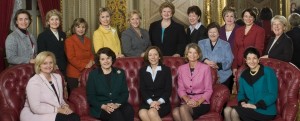Women’s Seats at Risk in the U.S. Senate
October 21, 2011
 By Jennifer Steinhauer for The New York Times – The 2012 elections are likely to mark the new “year of the woman” in the Senate. For better or worse.
By Jennifer Steinhauer for The New York Times – The 2012 elections are likely to mark the new “year of the woman” in the Senate. For better or worse.
Ten women — six of them incumbents — are presumed Democratic Senate nominees this year, and another is seriously considering a run. Republicans have one female senator, Olympia J. Snowe of Maine, up for re-election, and one presumed nominee, Linda Lingle of Hawaii, that state’s former governor. Other women in both parties are engaged in primary fights.
It is the greatest number of female incumbents ever up for re-election in the Senate, and would be among the highest number of nominees ever, which could add up to a banner year for women in the deliberative — and testosterone-infused — legislative body.
But, with Democrats endangered and Republicans lagging in recruitment of women — one of their own, Kay Bailey Hutchison of Texas, is retiring — it is also quite possible that in 2012, women could lose ground in the Senate for the first time in a generation.
“If it is a bad year for Democrats, it could be a bad year for women in the Senate,” said Debbie Walsh, the director of the Center for American Women and Politics at Rutgers University, noting that the majority of female elected officials nationwide were Democrats. “It is still early. Right now the numbers are lining up in such a way that it could go either way.”
Even as women have made strides in many areas of political life, Congress remains male dominated. From the galleries above, the Senate and House floors often appear to be a sea of red and blue ties, with the occasional mid-calf red skirt suit floating among them. Until just a few months ago, there wasn’t even a women’s restroom near the House floor.
The Senate has been a particularly tough electoral mountain for women to climb. In 1922, Rebecca L. Felton of Georgia served a mere 24 hours to replace a dead member, and from then on, women accounted for just one or two members — at times none at all — until 1993. It took the last two decades for the count to reach the current 17. If all or most of the incumbent women prevail in 2012, and even just a few women of the many recruited win new seats, women would reach an all-time high in the Senate. But the loss of just one female Senate seat with no replacements would cost women ground in the Senate for the first time since 1978, when the number of women in the Senate went to one from two.
This would continue a drift that began last year, when the number of women in the House fell by one, to 72. (A special election in New York in May brought the number back to 73.) State legislatures felt the pinch in 2010, when 81 women lost their seats, the largest such loss ever.
Women serving in the Senate are not eager to see their numbers shrink. “I think it is very important for legislative bodies to have women,” said Mrs. Hutchison, who recalled when she was among a handful of female lawmakers in the Texas legislature in the 1970s who crafted legislation to address how rape victims were treated in court.
“It wasn’t that the men were against our legislation,” she said, “It was just they never thought about the issue.”
Women in both parties are often more reluctant candidates, said several female senators, and those who advise them. “Men who have the slightly relevant experience will jump in without a second thought,” said Barbara Lee, president of the Barbara Lee Family Foundation, which works to engage women in politics. “Women need to be recruited and asked multiple times by multiple people in order to consider running.”
Unlike men, who tend to be attracted to public office because of their interest in politics, women often run because their interest is sparked by a single policy issue, often quite local. This dynamic is a theme of ABC’s hit show “Modern Family,” in which one main character, Claire Dunphy, a housewife, is running for town council against the male incumbent who refused her neighborhood a new stop sign.
To read the full article, click here.
